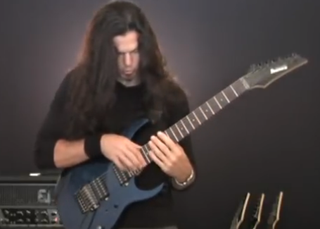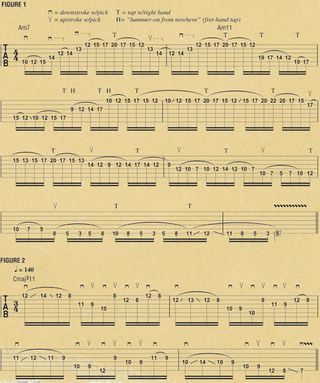Betcha Can't Play This: Chris Broderick's Arpeggio Etude

This first lick [FIGURE 1] is an arpeggio etude [musical-sounding exercise] in A minor that integrates tapping, multiple hammer-on and pull-off combinations and a little bit of economy picking into a steady stream of 16th notes.
It pretty much stays within the realm of the A minor pentatonic scale [A C D E G], with the flatted fifth, Eb, added in the last two bars.
Playing in this kind of way—with wide fret-hand stretches, taps and an occasional finger slide—helps you cover a wide swath of fretboard territory and yields a smooth, flowing sound.
This etude is an attempt to make the pentatonic scale sound more like an arpeggio. With this in mind, I include the chord symbol Am11 in bar 2. Notice in bar 1, however, that I purposefully avoid the note D, in effect creating an Am7 arpeggio [A C E G].
Notice that, when moving to a different string during the Am11 pentatonic section that begins midway through bar 2, I’ll initiate the first note on each successive string with either a pick-hand tap, an upstroke with the pick or a fret-hand tap. This latter technique, which is sometimes referred to as a ‘hammer-on from nowhere,’ is indicated by a capital H above the tab.
Try to articulate each note as clearly and loudly as possible; make every tap and hammer-on firm, and when pulling off, pull the string slightly in toward your fret-hand palm to keep the string vibrating. Also, try to mute the strings not being played to keep them from ringing sympathetically. This is accomplished primarily by lightly resting the palm of your picking hand on the strings whenever possible.
FIGURE 2 is a four-bar 16th-note run based on an exotic-sounding Cmaj7#11 arpeggio [C E G B F#]. Some people refer to this as a five-note scale—a ‘haiku,’ or something like that—but I like to thing of it as an arpeggio because it gives me a better concept about what I can do with the notes. For example, knowing that it is a maj#11 arpeggio tells me that I can play it over a IV [four] chord in a major key—in this case, G major—or over the VI [six] chord in a minor key—in this case, E minor.
Technically, this run is pretty straightforward, incorporating conventional picking with hammer-ons, pull-offs, finger slides and some string skipping. I would advise you to pay extra attention to picking clarity and efficiency, especially when string skipping. Try not to move the pick any more than you have to—just clear the strings, as opposed to ‘leaping’ or ‘bouncing’ over them.
If you check out the video for this lesson, you’ll notice I use a thumb pick. This is an attempt to bring together all the techniques I’ve worked on in my playing career, namely, classical, country finger picking, tapping and, of course, flat picking, in which case I press my index finger against the bottom side of the pick so that it feels like I’m holding a regular plectrum.
I have written some riffs that incorporate fast picking and strumming as well as two-hand tapping, and using a thumb pick enables me to quickly and conveniently transition from one technique to another. Using a thumb pick like a flat pick can feel a little weird, though, so I’m still experimenting with it.

Get The Pick Newsletter
All the latest guitar news, interviews, lessons, reviews, deals and more, direct to your inbox!

Want to play Master of Puppets the right way? Here's how to get faster at downpicking so you can chug like James Hetfield
![Joe Bonamassa [left] wears a deep blue suit and polka-dotted shirt and plays his green refin Strat; the late Irish blues legend Rory Gallagher [right] screams and inflicts some punishment on his heavily worn number one Stratocaster.](https://cdn.mos.cms.futurecdn.net/cw28h7UBcTVfTLs7p7eiLe-840-80.jpg)
“The intensity of Rory’s guitar playing – the emotion, the sound and his incredible attack – was mindblowing for me”: Joe Bonamassa pays tribute to the late, great Irish blues-rock icon Rory Gallagher

